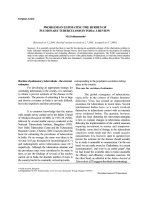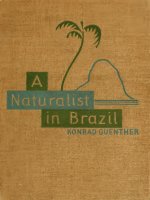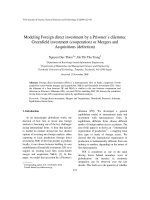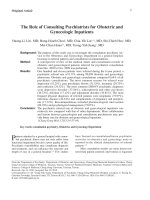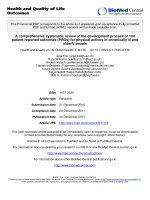A naturalist in Brazil; the record of a year''''s observation of her flora, her fauna, and her people pptx
Bạn đang xem bản rút gọn của tài liệu. Xem và tải ngay bản đầy đủ của tài liệu tại đây (26.89 MB, 472 trang )
from
the
library
of
Dr.
Ernest
Goodrich
Stillman
45
East
75th
St.
New
York
21
Ol
£0-
i
i
<^
:
CD
I
°
;
D
m
o
MARINE
BJOLOGICAL
LABORATORY
LIBRARY
—
WOODS
Hae,
mass.
w. H.
0. {.
NATURALIST
IN BRAZIL
THE FRANCISCAN
MONASTERY,
OLINDA
A NATURALIST
IN
BRAZIL
The
Record
of
a
Year
s
Observation
of
her
Flora
her
Fauna^
and her
People
BY
KONRAD GUENTHER
Professor
in
the
University of
Freiburg
TRANSLATED
BY
BERNARD MIALL
\
With Illustrations
BOSTON
AND NEW YORK
HOUGHTON MIFFLIN
COMPANY
The
German
origr/ial.
"Das AntUtz
Brasiliens,"
first published
by
R.
Voigtlanders Verlag,
Leipzig,
in
ig2y
FIRST
PUBLISHED
IN
ENGLISH
IN
1931
PRINTED IN THE
U.S. A.
TO MY
KINDLY
HOSTS
THE
VERY
REVEREND FATHERS
SUPERIOR
OF
THE
BENEDICTINE
MONASTERIES
D.
PETRUS
ROESER
ABBOT
IN OLINDA
D.
PETRUS
EGGERATH
D. MICHAEL
KRUSE
ARCH-ABBOT
IN RIO
ABBOT
IN SAO
PAULO
IN
HEARTFELT
GRATITUDE
AND FRIENDSHIP
the
year
of
my
sojourn
in
Brazil,
and
my subsequent
visit of some
months
to the
Argentine,
and
on
the
voyage
out,
I met
with
so
much kindness
and
hospitaUty
that
I
can
name
only
a few
of
my good
friends,
though they may
rest
assured
that none of them are
forgotten.
My
first
relations with Brazil were due to Fraulein
Elsa
Schwab,
of
Parahyba,
and
Professor
de
Barros,
whose
friendly
hospitality
I
subsequently enjoyed
at
his
home
in
Parahyba.
To the
Secretary
of State
of
Pernambuco,
Dr. Samuel
Hard-
man,
who
invited me
to
Brazil,
and in whom
I
always
found
sympathy
for and
understanding
of
my
work,
I
express
my
thanks
elsewhere.
For
the
greater part
of the time
I
enjoyed
the
hospitality
of the
Benedictine
monasteries,
to whose Abbots
this book
is therefore
dedicated;
but
I
have
grateful
memories
also of the Franciscans
in
Olinda, Bahia, Rio,
Petropolis
and
Sao
Paulo,
and of
the Benedictine nuns
in Misericordia
and Caruarii. For weeks
I
lived
in
the home
of
my good
friend
Dr. P. A. Nusse
and his
kindly
Portuguese
wife
;
in Sao Paulo
—
during
the difficult
days
of the Revolution
—
I
enjoyed
the
hospi-
tality
of
Herr Alfred and Frau
Alice
Weissflog
and
my
dear "Lion"
;
and in
Buenos
Aires
the time
spent
with
my
friend and
colleague
in the
protection
of
natural
beauties.
Professor
Hugo
Salomon,
and his wife
and
daughter,
made
a
happy
conclusion
to a
delightful
visit.
I must also
express my gratitude
to
my
kind
friend,
Dr.
Virginia Rodrigues,
and
her
children,
in
Olinda,
and
toSenhor
and
Senhora
A. O.
Coimbra,
Herr
and Frau
Bokmann,
and Herr and
Frau
A.
Kronke,
who
literally
made me feel at
home.
In
Rio,
Herr Kurl and Frau Elizabeth
Runge
and
her
daughter
Gisela were most
kind to
me,
and in
Sao
Paulo Herr Richers.
I must
thank the
German
Minister,
Dr.
Plehn,
and the German
Consuls
in
Recife,
Rio,
Sao
Paulo,
and
Santos,
for their
kindly
assistance,
and
the
German clubs for
their
friendly
hospitality. Among
the scientists
and scholars of
Brazil,
I
must
thank
Dr.
Lutz,
Dr. Costa Lima and Father
Borgmeier (O.F.M.)
in
Rio,
Herrn
Liiderwald,
Hoehne
and Decher in
Sao
Paulo,
and Professor
Lehmann Nitsche in
La Plata for
many
interesting
hours.
And I
do
not
forget
the hours
spent
with
Herr
Arp,
Dr.
Regendanz,
Dr.
ChristofTel,
and
above
all,
my
friend Dr. E.
Bethke.
JL
HE
German
title
of
this
book is Das
Antlitz
Brasiliens
—
"The Face
of Brazil."
The "face"
of
the
country
is
its
landscape,
its
flora,
its
fauna:
all
that we
include
by
the
word "Nature." These
things
constitute
its most
eloquent
and
impressive speech,
and to those who
can
hear it
—
and to
them
alone
—
the
country
reveals its
greatest
beauty,
and the intimate secrets
of its
being.
He who
wishes to derive
both
enjoyment
and
profit
from a
voyage
to
Brazil must above
all become intimate with the natural life of
the
country.
After
all,
what
is it that he most
of all
wants to
know?
He
wants,
I
think,
to
know the name
of
those
great
scarlet flowers
;
and what
sort
of
palms
those
are that overlook the
housetops
;
and
how
one can
best
enjoy
a
sight
of
monkeys,
parrots
and
humming-
birds. But
as
yet
he
has no
conception
of the wonders which are
revealed
by
an
insight
into
the lives of the orchids
and
the insects !
The best
Brazilian
"Baedeker" will therefore be
a
guide
to the flora
and fauna
of Brazil. And the task
which the author has
proposed
to
himself
in
the
writing
of this
book is
to
produce
such a
guide.
But the
glittering
virgin
forests,
the
sun-steeped
wildernesses,
the
sea-beaches
overshadowed
by
rustling
palm-trees, invariably
offered
me,
when
I went forth each
day
with
renewed
expectation,
so much
that
was new
and
lovely
and
fascinating,
that
I
very
soon formed
the
resolve to share
what
I had
felt
and seen with those for whom a
voyage
to
Brazil is
impracticable.
My
own
visit to that
country
followed
upon
an
invitation
from the Government
of the State of
Pernambuco
;
my
task was to combat
the
insects which
were
injuring
the
plantations.
My
work led me first
into
the
interior of
the north-
eastern
States,
and later
southwards,
to
Sao Paulo and
Jahu.
It not
only
gave
me
an
insight
into all the branches
of Brazilian
agriculture
and colonization
;
it led
also to
friendly
intercourse with the Brazil-
ians,
so
that I was able to
complete
my
description
of
the
country
and
its
civilization
by
some account
of
the
character and the customs
of its
human inhabitants.
This
book, therefore,
is based on
my
own
personal experiences,
just
as the illustrations
in
the
text are sketches from
my
own
pen,
while the
photographs
are
enlargements
from
my
own
negatives (I
used
a
stereoscopic
camera,
the
plates
being 4-5 by
10-7 cm.).
But it has
not
been
my
aim to
give
a
description
of
my
travels.
I
wish
rather that
my
own
experiences
might
enable
me to
transport
9
NATURALIST
IN
BRAZIL
the reader
bodily
into the scenes which I
have
described,
and enable
him
to
make
such
discoveries as
I
made
myself.
Even
the
expert,
I
hope,
may
find
something
new in
these
pages.
And
to
this
end
I
have
kept
all
personalities
in
the
background,
in
order that Nature
may speak
with her own
mighty
voice. In
each
chapter
the
image
of a
landscape
is
revealed in the
harmonious
co-operation
of its flora
and
fauna,
with
all
its characteristic colours and
voices and
perfumes.
Sixteen
years ago
I
was
able,
in
the same
way,
to
study
the Indian
island of
Ceylon,
so that
comparisons
between
the
two
tropical
countries
inevitably suggested
themselves
;
I
was able to define their
characteristic
features;
and
thus
my
book
deals
not
merely
with
the flora
and fauna of
Brazil,
but
also,
in a certain
degree,
with
tropical
Nature in
general
;
so that
I
hope
it
may
be
equally
welcome
to the
ordinary
reader and
to the scientist. And
if at
times
the
image
of
my
German homeland has
been
reflected in the mirror
of the
tropics,
this
juxtaposition
of
images
will but
more
sharply
define
the
individuality
of either
landscape.
Towards the end of
my sojourn
in the
country
I lectured in
Portuguese
before the
Agricultural
Society
and the
Faculty
of
Philosophy
in Sao
Paulo
;
and
I
also introduced
my
German
fellow-
countryfolk
in
Recife, Rio,
Sao Paulo and Buenos
Aires,
by
courses
of
lectures
and
instructional
excursions,
to the flora
and fauna of
Brazil.
Many
who attended these lectures
and excursions
have
assured
me that
they
have
now,
for the first
time,
learned to love
the
new home which has revealed to them so
many lovely
and
fascinating things,
of whose
existence,
in such
abundance,
and so
close at
hand,
they
had never had
any suspicion.
In
so
far
as
this
book
proceeds
a
little further on the lines thus
indicated,
it
has
yet
a
third
purpose:
to
be a book on
Brazil for the
Brazilians.
Nature
is here
considered not
by
the
critical
eye
of
an
outsider,
but
by
a
heart full of
love for the
sunny
land
;
and the
plants
and
animals
are
given
the
native
names
which
the Indians
have so
aptly
bestowed
on them.
The
scientific denominations
will
be found
in
the
Index,
which
is
almost
a
handbook in
itself,
and
which,
I
hope,
will
make
it
easier
for
subsequent explorers
and scientists
to
find their
way
about,
since in
addition
to
giving
the
derivation
and affiliation and
peculiar
features of
plants
and
animals,
it contains
references to the
principal
authorities for
those who desire
to
study
the
various
species
more
particularly.
May
the
readers of
my
book learn
to see the
face
of Brazil as
the
countenance
of
a
friend ! And when
they
have learned to
love
it,
lO
PREFACE
may
they
also
do
what lies within
their
power
to
prevent
its dis-
figurement,
and to ensure
that the
splendid
and
individual
flora
and
fauna of the
land shall be
preserved.
In
order to set
a
good
example,
I
refrained,
all the time I was in
Brazil,
as
I refrained
while
I
was
in
Ceylon,
from
ever
firing
a shot.
And
I
can here
assure the
reader
that the
best
way
of
understanding
a
whole
country
—
as it is the
best
way
of
understanding
an
individual
creature
—
is
to love it.
KONRAD
GUENTHER
II
CHAPTER
PAGE
PREFACE
9
LIST
OF
PLATES
15
LIST
OF
FIGURES
I?
I.
THE BEAUTY
OF
BRAZIL
21
II. THE
OCEAN
SHORE
3^
III.
THE SCAVENGERS
OF THE
SHORE,
AND THE MANGROVE WOODS
53
IV.
THE VIRGIN
FOREST
63
V. THE
LIANAS
88
VI.
EPIPHYTES
AND PARASITES
I
CO
VII. IN
THE DESERT
II3
VIII.
TROPICAL
GARDENS
I3I
IX.
PLANTATIONS
145
X.
THE ANIMAL
WORLD OF BRAZIL
1
58
XI.
NATURE
AS
AN ORGANISM
1
83
XII.
THE MOSAIC
OF COLOURS
206
XIII.
THE FLOWERS
OF BRAZIL
23O
XIV.
THE
SYMPHONY
OF VOICES
247
XV.
CAREFUL
MOTHERS
266
XVI.
PIONEERS OF COMMUNAL
LIFE : WASPS
AND
BEES
289
XVII.
THE
COMMUNITY
OF THE
ANTS
303
XVIII.
THE TERMITES
325
XIX.
SNAKES
AND
BLOODSUCKERS
337
XX.
THE BRAZILIANS
356
INDEX
WITH SCIENTIFIC
DENOMINATIONS OF PLANTS AND
ANIMALS,
THEIR
DERIVATION
AND
AFFILIATIONS,
AND
OTHER PARTICULARS
373
13
PLATE
I.
THE FRANCISCAN
MONASTERY,
OLiNDA
Frontispiece
SEASHORE
NEAR
TAMANDAR^,
PERNAMBUCO
,,
TO
FACE PAGE
II.
CLOISTERS OF
THE
BENEDICTINE MONASTERY
IN OLINDA
40
JANGADA (catamaran)
ON OLINDA
BEACH
40
iii. two of
the
islands of
recife
—
government palace
56
house in
caxanga,
near recife
56
iv.
bahia,
from the
immigrant steamer gelria
64
view
from
victoria,
espirito
santo
64
v.
the
entrance
to rio
bay,
from
the sugarloaf
72
the
atlantic
coast
to the north of
rio de
janeiro
72
vi.
view
from
the sugarloaf:
looking southwards
over rio
88
the
sugarloaf
88
vii.
the gave
a,
from
the shore
io4
the gave
a,
from
the
tijuca
forest
io4
viii.
olinda
120
coconut-palms
in olinda
i
20
ix.
cashew-wood,
pernambuco
1
28
oil-palms,
olinda i28
macaiba-palms
1
28
x.
mangrove
forest
near rio
1
36
urubu
vultures
i
36
swamp-crab
136
xi.
the
edge of the
forest,
alto
da serra
i44
edge of
barren
lands,
pernambuco
i44
forest
south of
rio
i44
xii.
seringal.
tree-tops
in the forest
160
seringal.
massaranduba
tree
160
xiii.
virgin
forest,
alto
da serra.
in
the
centre,
a
palmito
162
on
the
rio
paquequer,
near therezopolis
1
62
xiv.
virgin
forest,
ceylon
1
76
virgin forest.
kubany,
the bohmerwald
1
76
xv.
virgin
forest,
seringal 1
78
burity-palm
in swamp-forest
1
78
llanas
in virgin
forest,
pernambuco 1
78
xvi.
tree-ferns
in
forest
near nova friburgo
(2,6oo
feet above
sea-level)
184
TREE-FERNS
IN CEYLON
(aT
6,500
FEET)
FOR COMPARISON
184
15
A
NATURALIST
IN BRAZIL
PLATE
TO FACE
PAGE
XVII.
PETROPOLIS.
IN
THE
FOREGROUND,
GERMAN SCHOOL-CHILDREN
1
92
ARAUCARLA.S
IN FRONT OF
THE
YPIRANGA
MUSEUM,
SAO
PAULO
1
92
XVIII.
BROMELIAS
IN PERNAMBUCO
200
ARISTOLOCHIA
GIGANTEA
IN
THE BOTANICAL
GARDENS OF
PER-
ADENIYA,
CEYLON
200
XrX.
TREE-STRANGLING
FIG, PARAHYBA,
STILL
GROWING
ON THE
SUP-
PORTING
TREE
208
OLD
TREE-STRANGLING
FIG,
MATURE,
AT
MONTE,
OLINDA
2o8
XX. IN
THE
DESERT OF
PARAHYBA
2l6
PILLAR-CACTUS
AND FIG-CACTUS
2l6
XXI.
A
FERREIRO'S
NEST
232
VULTURE-NETTLE-TREE
232
PILLAR-CACTUS
232
OITICICA
232
XXII.
MANGO-TREE,
SHOWING
FRUIT,
AND MACAIBA-PALMS
256
BREADFRUIT-TREE
256
JACA-TREE
256
XXIII. CASTOR-OIL
PLANT
AT THE EDGE OF
THE FOREST
272
SUGAR-CANE,
TAPERA,
PERNAMBUCO
272
XXIV.
VIEW OF
THE "pARROT's
BEAK,"
TIJUCA
MOUNTAINS
288
BUILDING A
negro's
HOUSE
288
TRAVELLING
BY TROLLEY
288
XXV.
COTTON-FIELD,
SOLIDADE,
PARAHYBA
296
COFFEE PLANTATIONS
IN THE
HILLS
NEAR
JAHU
296
EUCALYPTUS
FOREST,
CAYEIRAS
296
XXVI.
LA PLATA
MUSEUM,
ARGENTINA
298
PREHISTORIC
GIANT
ARMADILLO
IN THE
LA PLATA
MUSEUM
298
XXVII.
THE MORE
PRIMITIVE MAMMALS
OF BRAZIL
3^2
XXVIII.
BIRDS OF BRAZIL
34°
xxnc.
(i)
MIMICRY
344
(11)
INSECTS WHICH MIMIC LEAVES
AND
TWIGS,
AND SOME
OTHERS
344
XXX. termites' NEST ON THE LAND
OF THE
AGRICULTURAL
COLLEGE,
TAPERA
346
SAGUIM
MONKEY
346
DRAWING
VIRUS FROM
A
RATTLESNAKE,
BUTANTAN
INSTITUTE
346
XXXI. BRAZILIAN SNAKES
352
XXXII. THE OLDEST
HOUSE IN
BRAZIL,
PARAHYBA
3^^
A HOUSE
IN
RECIFE
3^^
16
LIST
OF FIGURES
FIG,
PAGE
1.
TWO FRUITS
OF
THE
CASHEW-TREE,
ON
LEAF
4
1
2.
THE CARAVELLA
(pHYSALIA).
A
JELLY-FISH
(pELAGIA).
A
COFFER-FISH
45
3.
A
SECTION
OF
A LIANA STEM
9°
4.
LEAF OF THE
CLIMBING
PALM,
JACYTARA.
YOUNG
SHOOT OF
THE "cAt's-
CLAW"
CREEPER
93
5.
SECTION
OF
STEM OF A
BAUHINIA
95
6. BLADDER-TRAPS
ON THE
ROOTS
OF THE
BLADDERWORT
I08
7.
THE
"greybeard,"
AN EPIPHYTIC
BROMELIA
IO9
8.
AGAVE IN
BLOOM
I16
9.
SPRIG
OF
COTTON-PLANT
1
52
ID.
ITAWIRA,
ON THE
COAST OF
ESPIRITO SANTO
161
11.
PIRANHA
176
12.
MANATEE OR
PEIXE BOI
1
93
13.
PASSION-FLOWER
OR
MARACUJA
23
1
14.
A
TROPICAL
ORCHID
242
15.
A
FIG,
IN
SECTION,
SHOWING
THE INTERIOR OF THE
URN,
WITH THE
GALLS
OF
THE GALL-WASP.
A SINGLE FLOWER
WITH
THREAD-LIKE PISTIL
244
16.
THE
YUCCA-MOTH
245
17.
LEAVES
GLUED TOGETHER
BY
A
CAT-FROG
AND CONTAINING
THE
EGGS
272
18. GOELDI FROG
WITH A POCKET OF
EGGS ON
HER BACK
273
19.
THE PURSE
FROG
273
20.
SALAMANDER-FISH
275
21.
FLAT-HEADED
CATFISH
WITH EGGS ON
BELLY
276
22.
HERCULES BEETLE
278
23.
ICHNEUMON
ON
CATERPILLAR
282
24.
NEST
OF THE PASTEBOARD-WASP.
A NEST OF POLYBIA SCUTELLARIS
294
25.
STINGLESS BRAZILIAN
BEES
297
26.
LEAF-CUTTING
ANTS
OR
SAUVAS
303
27.
THE
SAUVAs'
GUEST,
SHOWING
THE
HAIRS WHICH
EXUDE AN
INTOXICATING
SAP
307
28. SAUVA
qUEEN
IN HER
CLOSED
BURROW
3IO
29.
SOLDIER
OF
THE
DRIVER ANT
312
30.
MIMECITON,
A BEETLE WHICH MIMICS
AN
ANT
318
31.
ANT-GARDEN ON THE BRANCH OF
A TREE
318
32.
SECTION
OF AN
IMBAUBA-TREE,
INHABITED
BY ANTS
319
33.
TUBULAR NEST OF THE BEARD AZTEC
32O
34.
TERMITE SOLDIER
326
B
17
A
NATURALIST IN
BRAZIL
^IG.
PAGE
35.
SOLDIER AND WORKER
OF
EUTERMES
RIPPERTII
327
36.
SCHEMATIC REPRESENTATION
OF A
NEST OF
EUTERMES
RIPPERTII
328
37.
TERMITE
qUEEN
SURROUNDED
BY
WORKERS AND
GUARDED
BY
A
RING
OF
SOLDIERS
329
38.
A
FLY,
THE
GUEST OF
THE
TERMITES
335
39.
FEMALE SAND-FLEA OR
JIGGER
35
1
40.
HEAD
OF HOOKWORM FROM HUMAN
INTESTINE. THE
LARVAL
STATE
353
PRONUNCIATION
OF BRAZILIAN
NAMES
c
before
a, o,
u
=^
k;
before
e, i,
y
^^
ss.
g
=
ss.
ch
=
sh.
g
before
a, o,
u
is
hard
;
before
e,
i,y,
soft
like the French
j.
j
=
the French
J.
h is
mute.
In Ih and nh
=
j.
s
at the
beginning
of a word is
sharp.
qu
=
usually
k.
X
usually
=
sh,
but sometimes
a soft
s
(Caxirra
=
Casirra).
Z
—
soft
s.
~
written above
a
vowel
indicates a nasal n. Sao
=
Ssaonj',
a and o
constituting
a
diphthong.
ei
=
closed
a,
or
French
e.
A final e
usually
becomes
an
impure
i,
and
a final
=
usually
u. M and
n
are often nasal : Sem fim
=
ssen^
f
hin^.
The
accent
'
indicates that
the
vowel is
open,
and
usually emphasized.
In
Brazil a more clear-cut
and
less eroded
Portuguese
is
spoken
than in
Portugal.
The
language
of
the
Discoverers,
which was
nearer
Spanish
than is the
language
of
to-day,
has survived
in
Brazil
;
it
is
a
language
of
great
beauty,
and
very
musical.

